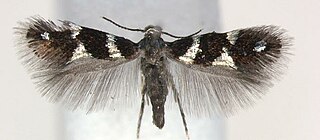
The Heliozelidae, commonly known as shield-bearer moths, are a family of small, day flying monotrysian moths distributed worldwide. The larvae of most heliozelid species are leaf miners who cut distinctive shield-shaped cases from the surface of the host leaf, hence the common name. Some species are considered pests of commercial crops such as grapevines, cranberries, and walnuts. The taxonomy of this family is poorly understood.

Antispila is a moth genus of the family Heliozelidae. It was described by Jacob Hübner in 1825.
Antispila ampelopsia is a moth of the family Heliozelidae. It was described by Kuroko in 1961. It is found in Japan.

Antispila argostoma is a moth of the family Heliozelidae. It was described by Edward Meyrick in 1916. It is found in India.

Antispila aristarcha is a moth of the family Heliozelidae. It was described by Edward Meyrick in 1916. It is found in India.
Antispila chlorosema is a moth of the family Heliozelidae. It was described by Edward Meyrick in 1931. It is found in Chile.
Antispila freemani is a moth of the family Heliozelidae. It was described by J. Donald Lafontaine in 1973. It is found in North America, including Ontario and British Columbia.
Antispila inouei is a moth of the family Heliozelidae. It was described by Kuroko in 1987. It is found in Japan.
Antispila isorrhythma is a moth of the family Heliozelidae. It was described by Edward Meyrick in 1926. It is found in India.
Antispila nolckeni is a moth of the family Heliozelidae. It was described by Philipp Christoph Zeller in 1877. It is found in Colombia.
Antispila orthodelta is a moth of the family Heliozelidae. It was described by Edward Meyrick in 1931. It is found in Brazil.
Antispila pentalitha is a moth of the family Heliozelidae. It was described by Edward Meyrick in 1916. It is found in Guyana.
Antispila postscripta is a moth of the family Heliozelidae. It was described by Edward Meyrick in 1921. It is found in Peru.
Antispila praecincta is a moth of the family Heliozelidae. It was described by Edward Meyrick in 1921. It is found in Brazil.
Antispila tateshinensis is a moth of the family Heliozelidae. It was described by Kuroko in 1987. It is found in Japan.
Antispila uenoi is a moth of the family Heliozelidae. It was described by Kuroko in 1987. It is found in Japan. In 2018, the species was found from China.

Aspilanta ampelopsifoliella is a species of moth in the family Heliozelidae. It is found in eastern North America. The larvae are leaf miners that feed on Virginia creeper and false Virginia creeper.

Aspilanta voraginella is a species of moth in the family Heliozelidae, first described by Annette Frances Braun in 1927. It is found in the United States. The larvae are leaf miners that feed on Vitis arizonica.

Aspilanta is a genus of very small moths in the family Heliozelidae that is native to North America. The larvae are leaf miners. Most Aspilanta species feed on Vitaceae with the exception of A. hydrangaeella and A. argentifera, which feed on species of hydrangea and Myricaceae respectively. The name of the genus is a partial anagram of Antispila.





